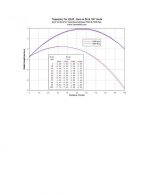Gene,
I'll give it a "shot." If every cartridge in a group produced the same muzzle velocity and bullet exit time, compensation would not be required. But if we take as a given that there will be a range of velocities and bullet exit times within a group, we know from external ballistics alone that if the bullets are launched at the same angle, the slower bullets will hit the target lower. To get them to hit the target at the same elevation, we want to point the muzzle higher for the slower bullets. How do we know which bullets are slower? They are the ones that also travel through the barrel slower and have a later bullet exit time. How do we achieve compensation without knowing a priori which bullets are slower? We tune the system so that the muzzle angle is rising throughout the interval when all the bullets exit. For perfect compensation, the muzzle needs to be at just the right angle to offset the extra drop that occurs for the slower bullet at the distance we are shooting. At longer ranges, we need the muzzle angle to be higher for the slow bullet than at short range. Thus the muzzle angle must be increasing faster, because the delay time for the slow bullet is the same. VarmintAl shows a nice graph of this principle for a 22RF at 50 and 100 yards. I hope he doesn't mind me attaching it here.
View attachment 15314
Geoffrey Kolbe wrote a nice article about compensation here:
http://www.geoffrey-kolbe.com/articles/rimfire_accuracy/tuning_a_barrel.htm
I think of tuners as fine-tuning the high frequency noise out of the muzzle angle path. Changing yardages requires a substantial change in the overall angular velocity of the muzzle. In principle, this could be done by moving the tuner (a lot), but I choose to make the big change some other way (e.g., moving the forend in the front rest) and keep the tuner for fine-tuning, so that I don't lose track of multiple turns.
Hope this helps,
Keith


